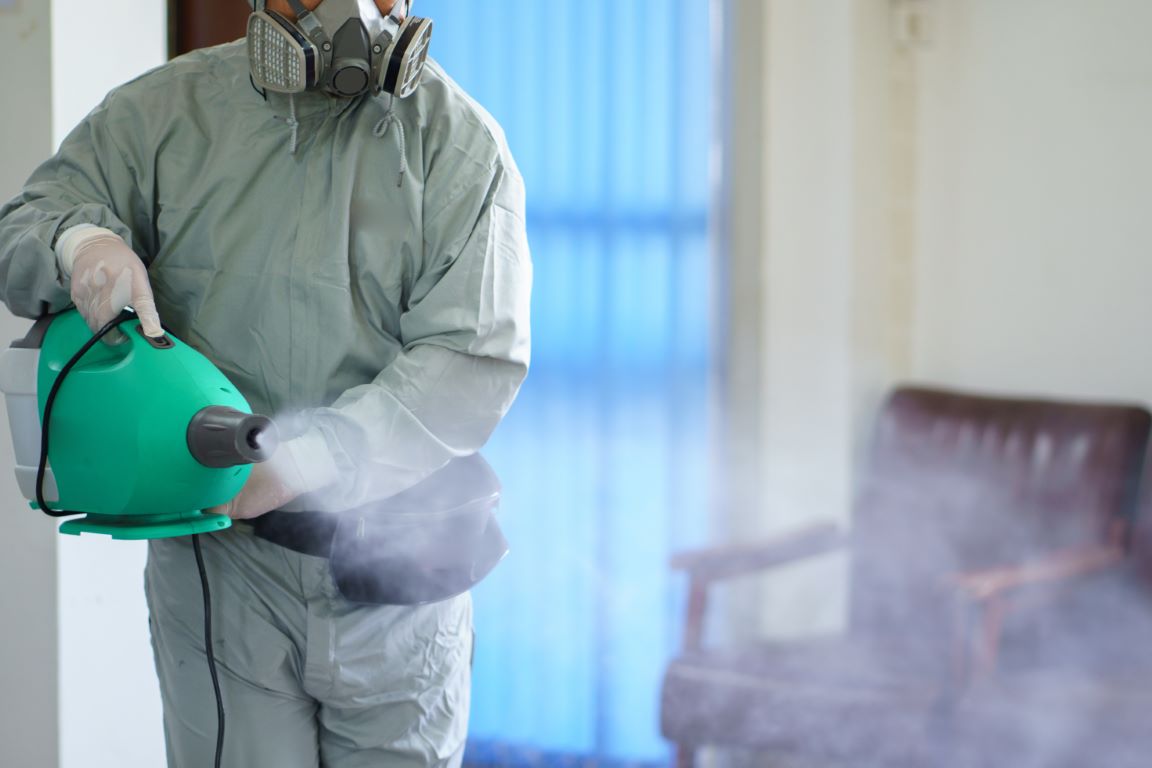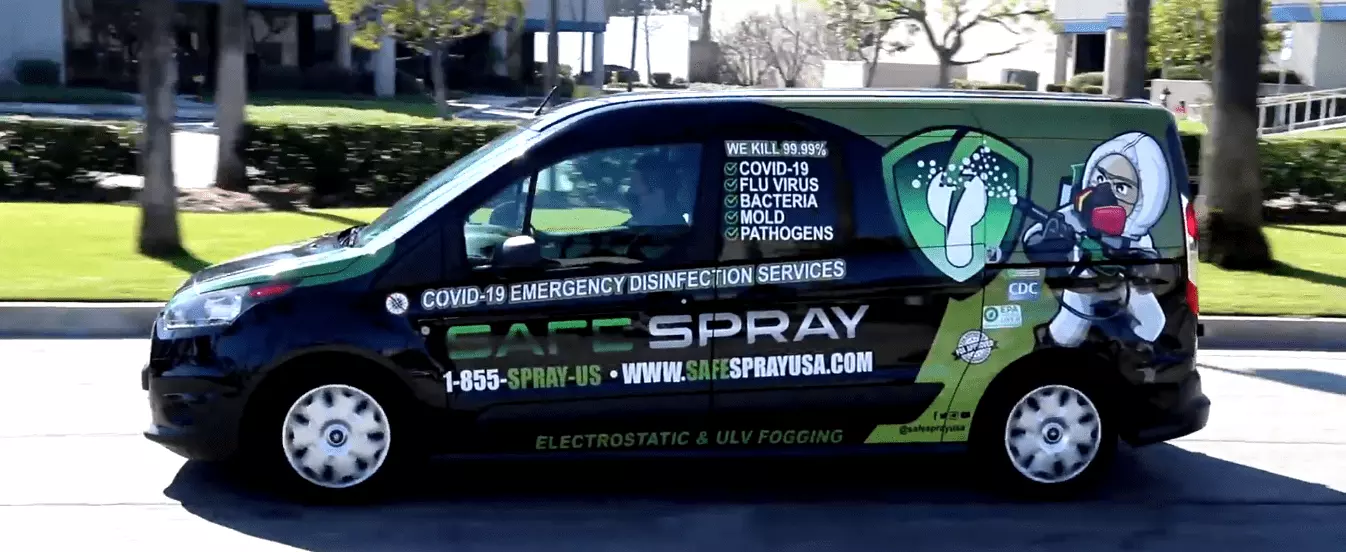Get a Free Estimate
Your information will not be shared. Safe Spray will send you a custom estimate.

Maintaining a clean and hygienic environment is often important for safeguarding public health and preventing the spread of infections in your office, school, or other business environments. When discussing cleaning practices, two terms often used interchangeably are “disinfection” and “sanitization.” While both aim to reduce the presence of harmful microorganisms, they serve different purposes and involve distinct processes.
Below, we will look closely at the definitions, key differences, methods, and effectiveness of disinfection and sanitization. Understanding these aspects is essential for making informed choices about germ control in various settings.
Definitions of Disinfection and Sanitization
Disinfection:
Disinfection is a process that involves using chemical agents to eliminate or significantly reduce the number of pathogenic microorganisms on surfaces. The goal of disinfection is to render the environment safe by killing a broad spectrum of bacteria, viruses, fungi, and other harmful organisms. Disinfectants are typically more potent than sanitizers and are used in situations where a higher level of microbial reduction is required.
Sanitization:
Sanitization, on the other hand, is a process that reduces the number of microorganisms on surfaces to a level deemed safe by public health standards. Sanitizers are generally effective against a specific subset of microorganisms, such as bacteria and some viruses, rather than the broad spectrum targeted by disinfectants. Sanitization aims to create an environment that is hygienic and lowers the risk of infection, but it may not necessarily eliminate all pathogens.
Key Differences Between Sanitization and Disinfection
Understanding the distinctions between disinfection and sanitization is essential for employing the right approach in different contexts. Here are the key differences:
1. Microbial Reduction
- Disinfection: Aims to kill or eliminate a broader range of microorganisms, including bacteria, viruses, fungi, and some spores.
- Sanitization: Focuses on reducing the number of specific microorganisms, often bacteria, to levels considered safe by health standards.
2. Potency of Agents
- Disinfection: Involves the use of more potent chemical agents known as disinfectants.
- Sanitization: Uses milder agents known as sanitizers.
3. Level of Reduction
- Disinfection: Achieves a higher level of microbial reduction compared to sanitization.
- Sanitization: Reduces microbial levels to a level considered safe for public health.
4. Application Areas
- Disinfection: Commonly applied in healthcare settings, laboratories, and environments where a higher level of sterility is required.
- Sanitization: Widely used in foodservice, childcare, and other settings where reducing the risk of bacterial contamination is the primary goal.
When to Use Disinfection
1. High-Risk Environments
- Healthcare Facilities: Disinfection is crucial in healthcare settings to prevent the spread of infections among patients and healthcare workers.
- Laboratories: Laboratories where sterile conditions are essential require disinfection to eliminate the risk of cross-contamination.
2. Emergencies and Outbreaks
- Outbreak Response: During disease outbreaks, disinfection plays a key role in controlling the spread of infectious agents in affected areas.
3. High-Touch Surfaces
- Public Spaces: Surfaces that experience high traffic, such as doorknobs, handrails, and elevator buttons, benefit from regular disinfection to minimize the risk of transmission.
4. Suspected Contamination
- Biohazard Incidents: In the aftermath of biohazard incidents, disinfection is essential to neutralize potential contaminants.
When to Use Sanitization
1. Food Handling and Preparation
- Restaurants: Sanitization is crucial in restaurants to reduce the risk of foodborne illnesses on surfaces where food is prepared and served.
- Food Processing Plants: Sanitization helps maintain a hygienic environment in food processing facilities.
2. Childcare Facilities
- Daycares and Schools: Sanitization is employed to reduce the transmission of common illnesses in childcare settings.
3. Household Surfaces
- Home Environments: Sanitization of commonly touched surfaces in homes helps prevent the spread of bacteria among family members.
4. Public Transportation
- Public Transport: Sanitization of high-touch surfaces in buses, trains, and other public transportation vehicles is crucial to protect passengers.
Methods and Products for Disinfection and Sanitization
Disinfection:
- Chemical Disinfectants: Chemical agents like bleach, hydrogen peroxide, and quaternary ammonium compounds are common disinfectants.
- UV-C Light: Ultraviolet (UV) light with a wavelength of 254 nanometers has germicidal properties and is used for disinfection in certain settings.
- Electrostatic Disinfection: This innovative method involves applying an electric charge to disinfectants, enabling them to evenly coat and adhere to surfaces.
Sanitization:
- Alcohol-Based Sanitizers: These typically contain ethanol or isopropyl alcohol and are effective against a range of bacteria.
- Quaternary Ammonium Compounds: Commonly found in sanitizing solutions, these compounds are effective against bacteria and some viruses.
- Steam Cleaning: High-temperature steam is used to sanitize surfaces and eliminate certain microorganisms.
Effectiveness and Limitations of Disinfection and Sanitization
Disinfection:
Effectiveness:
- Highly effective at killing a broad spectrum of microorganisms.
- Provides a high level of microbial reduction.
Limitations:
- Some disinfectants may have specific targets and may not be effective against all types of microorganisms.
- Overuse of certain disinfectants may lead to the development of resistant strains.
Sanitization:
Effectiveness:
- Effective against specific microorganisms, particularly bacteria.
- Reduces the risk of infection to a safe level.
Limitations:
- May not eliminate all types of pathogens, including viruses and spores.
- The level of microbial reduction may be lower compared to disinfection.
Choosing the Right Approach for Effective Germ Control
The choice between disinfection and sanitization depends on the specific goals, environments, and regulatory requirements. In healthcare settings, where the risk of infections is higher, prioritizing disinfection is essential. Conversely, in environments like restaurants and childcare facilities, where reducing bacterial contamination is the primary concern, sanitization may suffice.
Contact Safe Spray to Disinfect and Sanitize Your Office, Hospital, or Other Commercial Space
In the ongoing battle against infectious diseases, sanitization vs disinfection often comes up. While both practices contribute to creating a safer and healthier environment, their applications differ based on the level of microbial reduction required and the specific settings in which they are employed.
Whether in healthcare, foodservice, or everyday environments, choosing the right approach to remove germs is paramount in fostering a hygienic and safe world. Contact Safe Spray today for expert electrostatic disinfection services for your home or office or other business.

Get Your Free Quote Today!
We also offer a no obligation, free onsite service estimate.

 Get a free Consultation
Get a free Consultation